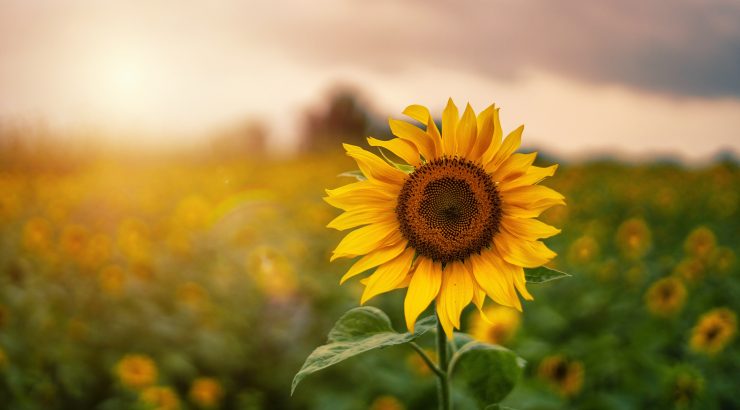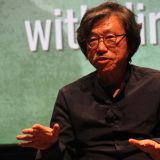
A Sunflower of History and Hope
March 4, 2022
If you research the meaning of sunflowers, you’ll find that they are a symbol of positivity and luck. They also represent peace and hope. Sunflowers happen to be the national flower of Ukraine, a country that in recent years has embraced these ideals in building an independent and democratic society. In just over a week, that society has been upended with Ukrainians now engaged in a fierce fight against an invader seeking to occupy their land and end their democracy.
 “The Sunflower” is also the name of one student’s film entry in the 23rd Annual Holocaust Art & Writing Contest, Turning Memory to Strength Living with Courage, Resilience and Hope on March 11, sponsored by Chapman University and The 1939 Society. In the film, the student explains how the sunflowers she planted became a sign of hope and resilience for her as she recovered from major surgery. She connected her love of sunflowers to the video testimony of Holocaust survivor Jadzia Stern, who risked her life when she was in Auschwitz, to touch the bright yellow flower growing just beyond the barbed wire fence. The filmmaker reminds us that “sunflowers are special because they always turn their faces toward the sun.” They inspired both survivor and student to do the same. Stories like this one connect us to each other and to history—and perhaps through that history to what is happening today.
“The Sunflower” is also the name of one student’s film entry in the 23rd Annual Holocaust Art & Writing Contest, Turning Memory to Strength Living with Courage, Resilience and Hope on March 11, sponsored by Chapman University and The 1939 Society. In the film, the student explains how the sunflowers she planted became a sign of hope and resilience for her as she recovered from major surgery. She connected her love of sunflowers to the video testimony of Holocaust survivor Jadzia Stern, who risked her life when she was in Auschwitz, to touch the bright yellow flower growing just beyond the barbed wire fence. The filmmaker reminds us that “sunflowers are special because they always turn their faces toward the sun.” They inspired both survivor and student to do the same. Stories like this one connect us to each other and to history—and perhaps through that history to what is happening today.
On Tuesday, March 1, as Russian forces attacked Kyiv, a missile targeting a TV tower killed five civilians and damaged the Babyn Yar memorial. In a tweet following the attack, Ukraine’s President Zelensky responded: “What is the point of saying ‘never again’ for 80 years, if the world stays silent as a bomb drops on the same site of Babyn Yar?” The United States Holocaust Memorial Museum issued a statement condemning “the continued Russian attacks on the Ukrainian people and loss of innocent lives, the exploitation of the Holocaust as a pretext for these attacks, the blatant disregard for historical truth, and the attack today at one of the most important memorial sites of the Holocaust.”
The U.S. Holocaust Memorial Museum statement offers some thought-provoking connections: murder of civilians, exploitation of the Holocaust, disregard for historical truth, and violence to a site of memory. Until Tuesday, and perhaps even after, most American students probably had no idea what or where Babyn Yar is. A Claims Conference survey that assessed knowledge of the Holocaust among Millennials and Gen Z reported that 63% did not even know that 6 million Jews were murdered in the Holocaust and 48% were unable to name a single camp or ghetto. One might ask, so what? We can’t change what happened. But then the question arises: How can we pledge “never again” if we don’t know to what the “never” refers?
In recounting his personal history, President Zelensky often speaks of the “four brothers,” all Jews, only one of whom, Zelensky’s grandfather, survived World War II and the Holocaust. Two generations removed from their fight against the Nazis, he draws strength from their memory as he leads the defense of democratic Ukraine. Of the roughly 6 million Jews murdered in the Holocaust, about 1.5 million were Ukrainian. Babyn Yar, where the Russian missile hit, is one of the largest killing sites of the Holocaust. Over the course of two days in September 1941, more than 33,000 Jews were slaughtered there.
As I watch the moving messages that President Zelensky is sending out to the world, I am reminded of another defiant and courageous fighter, Mordechai Anieliwicz, the leader of the Warsaw ghetto revolt. With Molotov cocktails and a few pistols, he and his band of young fighters stood up to a force of 2,000 heavily armed German soldiers. Today we are witnesses to another act of extraordinary heroism as a civilian population stands up to cluster bombs and missiles in defense of their freedom and their country.
I believe that the students who participated in this year’s Holocaust Art & Writing contest on the theme “Turning Memory to Strength: Living with Courage, Resilience and Hope” have learned what the words “never again” mean. As they grappled with the challenges of COVID, I think they found strength through the Holocaust they viewed. I believe that when they see injustice they will not be silent or indifferent. May the sunflower, symbol of hope, inspire us to transform “yet again” into “never again.”
Updated on March 18, 2022:
Ava Lazar’s film “Sunflower” won first place in the high school film category. Ava is from Blacksburg High School in Blacksburg, VA.
For a list of all the top-placing entries, click here!

